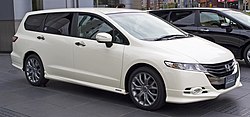What's in a name? It is neither hand, nor foot, nor any other part belonging to a van. In a reversal of the Romeo and Juliet story, the case of the US and Japanese versions of the Honda Odyssey minivan is one of distant cousins who have a name in common, but are otherwise quite unlike each other. Neither is a hybrid, alas.
The cousin who emigrated from Japan to the US went through a mirror and its steering wheel moved from the right to the left side of the car. Its dashboard design became more angular. Its seats became cushier. And both its body and its engine grew. There seems to be a growth ray that hits things as they pass the US border. CelloMom keeps checking to see if her wallet would be affected in the same way as we pass through US Immigration at the airport, but so far no such luck.

Surprisingly, the difference in fuel efficiencies is underwhelming: While the US cousin has a real-life fuel economy of 20 mpg, the Japanese cousin with the smaller engine is listed as getting 29 mpg under the Japanese JC08 standard, which according to CelloMom's rough translation corresponds to a real-life mileage in the range 21-24mpg. One would have expected more mileage gain from the smaller engine.
But the truth is, minivans and larger cars in Japan in general don't have great fuel economy, from what CelloMom has seen so far. CelloDad offers the conjecture that these minivans might be used more for family outings rather than the daily commute which happens mostly by public transportation, so mileage takes a back seat relative to seating capacity.
One observation supports this conjecture: In the US the feature touted most prominently is the entertainment system - wide-screen HDMI capability for the kids' row in the back, and 650W on the audio system, enough to turn the whole van into an oversized boombox.
 In contrast, the feature that gets its own button on the Japanese website is the chair lift option: The front passenger seat (on the left, of course) can be rotated and lowered almost to street level. It tells you that not only is there room for grandparents in the Japanese family van, but they come often enough that getting the chairlift option makes sense for those who need the extra help getting in and out of the car. If CelloMom's dad, now in his 80's, lived close by, this feature would make the Odyssey very attractive indeed.
In contrast, the feature that gets its own button on the Japanese website is the chair lift option: The front passenger seat (on the left, of course) can be rotated and lowered almost to street level. It tells you that not only is there room for grandparents in the Japanese family van, but they come often enough that getting the chairlift option makes sense for those who need the extra help getting in and out of the car. If CelloMom's dad, now in his 80's, lived close by, this feature would make the Odyssey very attractive indeed.
Honda Odyssey, US and Japan versions.
| US | Japan | |
| Type | LX | M-FF (2WD) |
| Year | 2011 | 2011 |
| Emissions rating | ULEV-2 | |
| MSRP | US$ 28,225 | |
| CelloMomRating |

|

|
| City/Hwy (mpg) | 18 / 27 | |
| avg. quoted | 21mpg (EPA) | 12.4 km/l (JC08) (29mpg) |
| avg. actual | 20mpg (DOE) | |
| Engine | 3.5L V6, 24-valve SOCH-iVTEC |
2.4L DOCH i-VTEC |
| Power | 248 HP @ 5700 rpm | 173 HP @ 6000 rpm |
| Gears | 5-spd auto | CVT auto |
| Fuel | Regular unleaded | |
| Length, mm(in) | (202.9in) 5154mm | 4800mm (189.0in) |
| Width, mm(in) | (79.2in) 2011mm | 1800mm (70.9in) |
| Height, mm(in) | (68.4in) 1737mm | 1545mm (60.8in) |
| Weight, kg(lbs) | (4337lbs) 1967kg | 1600kg (3527lbs) |
| Trunk volume, liters(cuft) | (38 / 93 / 149 cuft) | |
| Turning radius, m(ft) | (36.7ft) | 10.8m (35.4ft) |
| Top speed, kph(mph) | ||
No comments:
Post a Comment
You have an opinion: Let's hear it.
(Comments are moderated; please be patient).